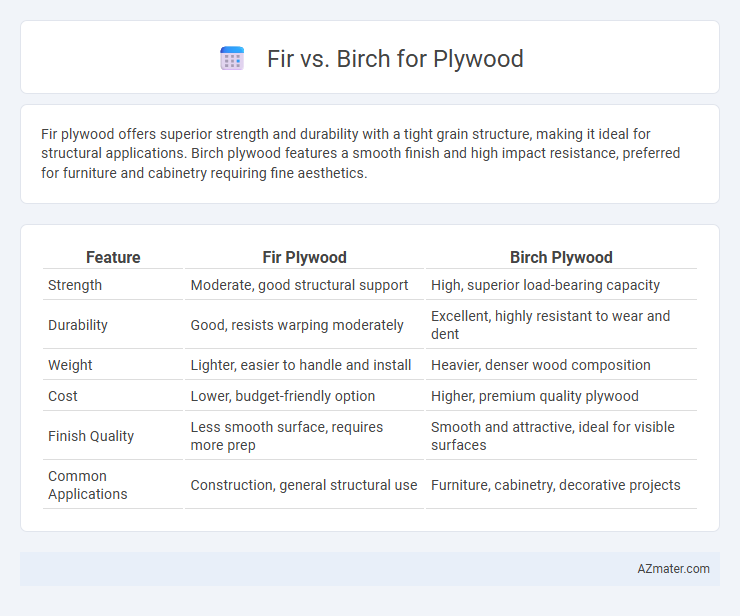Fir plywood offers superior strength and durability with a tight grain structure, making it ideal for structural applications. Birch plywood features a smooth finish and high impact resistance, preferred for furniture and cabinetry requiring fine aesthetics.
Table of Comparison
| Feature | Fir Plywood | Birch Plywood |
|---|---|---|
| Strength | Moderate, good structural support | High, superior load-bearing capacity |
| Durability | Good, resists warping moderately | Excellent, highly resistant to wear and dent |
| Weight | Lighter, easier to handle and install | Heavier, denser wood composition |
| Cost | Lower, budget-friendly option | Higher, premium quality plywood |
| Finish Quality | Less smooth surface, requires more prep | Smooth and attractive, ideal for visible surfaces |
| Common Applications | Construction, general structural use | Furniture, cabinetry, decorative projects |
Introduction to Fir and Birch Plywood
Fir plywood is renowned for its strength, durability, and smooth surface, making it ideal for construction and cabinetry applications. Birch plywood offers superior hardness and a fine grain, providing a high-quality finish suitable for furniture and decorative panels. Both types are widely used in plywood manufacturing, with fir valued for structural support and birch favored for aesthetic appeal.
Botanical Differences Between Fir and Birch
Fir plywood is derived from species in the Abies genus, characterized by softwood with straight grain and uniform texture, while birch plywood comes from Betula species, a hardwood known for its fine grain and pale color. Fir trees typically exhibit needle-like leaves and cones, distinguishing them botanically from birch trees, which have broad, deciduous leaves and produce catkins. These botanical differences influence the plywood's density, durability, and workability, with fir offering lightness and stability, and birch providing strength and smooth finish.
Physical Properties: Fir vs Birch
Fir plywood exhibits moderate strength and excellent dimensional stability, making it suitable for construction projects requiring resistance to warping and twisting. Birch plywood is denser and harder, offering superior strength, durability, and a smooth surface ideal for furniture and cabinetry. The higher hardness and fine grain of birch provide better wear resistance, whereas fir offers lighter weight and easier machinability.
Strength and Durability Comparison
Fir plywood offers superior strength and durability compared to birch plywood, making it ideal for structural applications where load-bearing capacity is crucial. Birch plywood is dense and hard, providing excellent resistance to impact and wear, but it is generally less flexible and more prone to splitting under heavy stress. Fir plywood exhibits better dimensional stability and resistance to warping, ensuring longer lifespan in construction and furniture projects.
Appearance and Grain Texture
Fir plywood features a straight, uniform grain with a light reddish-brown hue, offering a smooth and consistent appearance ideal for clear finishes. Birch plywood displays a fine, tight grain pattern with a pale cream color, providing a clean and bright look often preferred for decorative surfaces. Both woods deliver distinct aesthetic qualities, with fir highlighting warmth and subtle texture, while birch emphasizes clarity and a refined, elegant grain.
Workability and Ease of Use
Fir plywood offers excellent workability due to its straight grain and uniform texture, allowing for easy cutting, shaping, and fastening. Birch plywood is renowned for its smooth surface and fine grain, which provides superior sanding quality and a high-quality finish. Both woods are easy to work with hand and power tools, but birch's denser composition can require slightly more effort during milling and fastening compared to fir.
Cost and Availability
Fir plywood is generally more affordable due to the widespread growth of Douglas fir trees, ensuring consistent availability and lower transportation costs. Birch plywood tends to be more expensive because birch trees are less common and the wood has a denser grain, which requires more processing. Availability of fir plywood is higher in North America, while birch plywood, often sourced from Europe or Russia, may have longer lead times and fluctuating prices.
Environmental Impact and Sustainability
Fir plywood is often preferred for its faster growth rate and higher carbon sequestration compared to birch, contributing to a lower environmental footprint. Birch plywood, while denser and more durable, typically requires slower-growing hardwood trees, which can lead to greater resource depletion. Sustainable harvesting practices and certifications like FSC or PEFC are critical in minimizing the environmental impact of both fir and birch plywood production.
Common Applications in Construction and Furniture
Fir plywood is widely used in construction for its strength and dimensional stability, making it ideal for structural applications such as sheathing, subflooring, and framing. Birch plywood, prized for its fine grain and smooth surface, is preferred in furniture making and cabinetry where aesthetic appeal and a high-quality finish are crucial. Both woods offer durability, but fir excels in load-bearing contexts while birch is favored for decorative and detailed interior surfaces.
Choosing the Best Option: Fir or Birch for Your Project
Fir plywood offers superior strength and dimensional stability, making it ideal for structural projects and heavy-duty applications, while birch plywood provides a smoother surface finish, excellent for cabinetry and furniture requiring high-quality aesthetics. Fir is typically more affordable and widely available, whereas birch is denser and harder, enhancing durability and resistance to wear. Selecting between fir and birch depends on project demands for strength, appearance, and budget constraints.

Infographic: Fir vs Birch for Plywood
 azmater.com
azmater.com